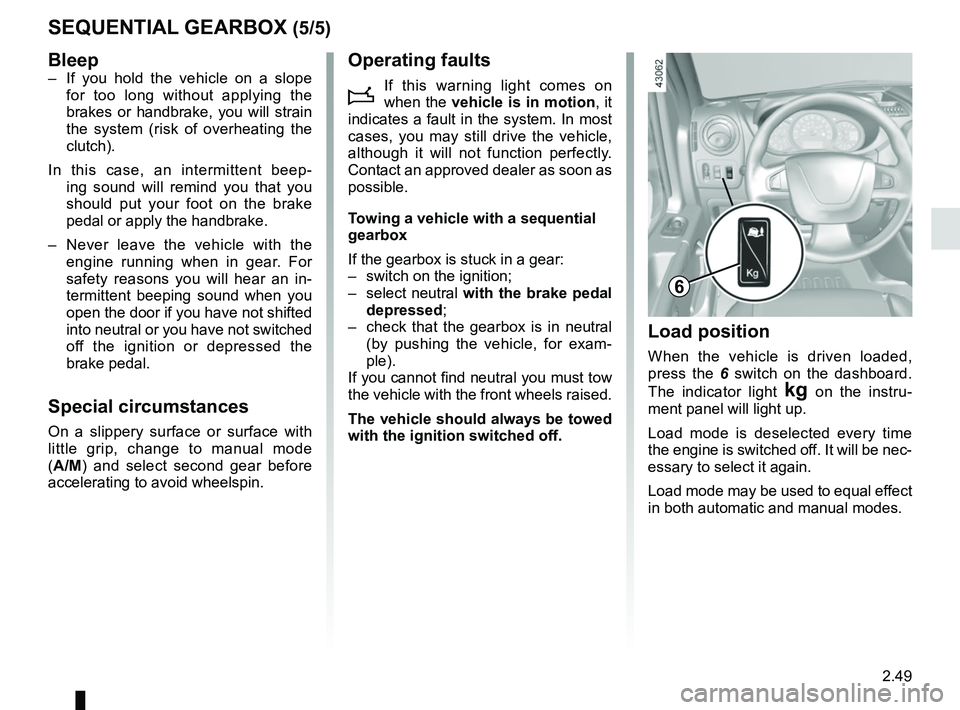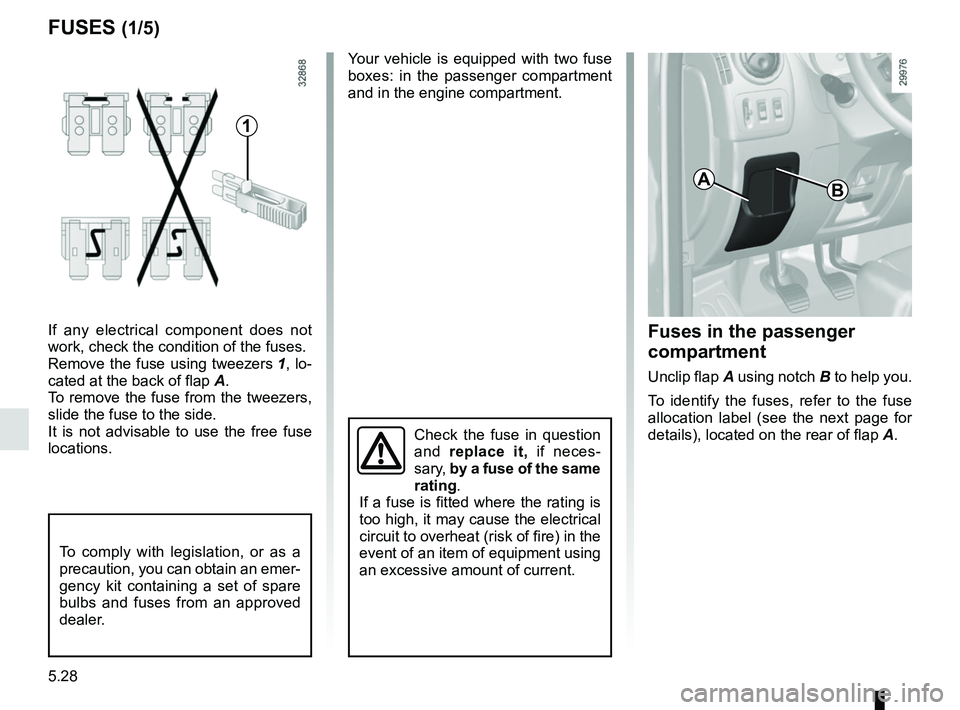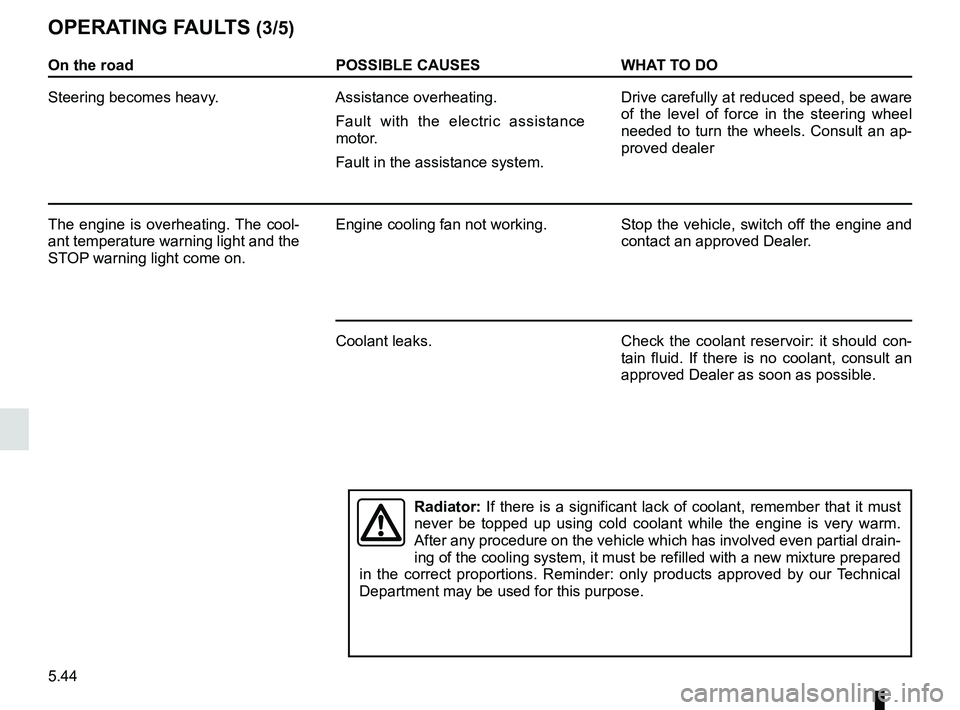engine overheat RENAULT MASTER 2018 Owners Manual
[x] Cancel search | Manufacturer: RENAULT, Model Year: 2018, Model line: MASTER, Model: RENAULT MASTER 2018Pages: 290, PDF Size: 7.1 MB
Page 85 of 290

1.79
WARNING LIGHTS (2/4)
The presence and operation of the warning lights DEPEND ON THE EQUIPMENT\
AND COUNTRY.
DHandbrake on and brake cir-
cuit incident warning light
This comes on when the ignition is
switched on and goes out as soon as
the handbrake is released. If it comes
on during braking or when the vehicle
is being driven, accompanied by the
® indicator light, it means that one
of the circuit levels is too low; it may be
dangerous to continue driving. Consult
an approved dealer.
\bTyre pressure loss warning
Please refer to the information
on the “Tyre pressure loss warning” in
Section 2.
©Warning light
This comes on when the igni-
tion is switched on and goes out after
about 3 seconds. If it comes on, pos-
sibly accompanied by other warning
lights, you should visit an approved
dealer as soon as possible. Depending
on the vehicle, this warning light is ac-
companied by a message on the instru-
ment panel.
ÄToxic fume filter system
warning light
On equipped vehicles, the light comes
on when the ignition is switched on then
goes out.
– If it lights up continuously accom- panied by the
© warning light,
please consult an authorised dealer
as soon as possible;
– if it flashes, reduce the engine speed until the light stops flashing. Contact
an approved dealer as soon as pos-
sible.
Please refer to the information on
«Maintenance and anti-pollution
advice» in Section 2.
åIndicator light Airbag
This light comes on when the
ignition is switched on and goes out
within about 3 seconds. If it comes on,
there is a fault in the system. Contact
an approved dealer as soon as possi-
ble.
2
Door status warning light
If it lights up when the ignition
is switched on, it indicates that
a door is not properly closed.
ÜNot used
®STOP light
This comes on when the igni-
tion is switched on and goes out after
about 3 seconds.
If it comes on, possibly accompanied
by other warning lights, stop soon as
traffic conditions allow. Contact an ap-
proved dealer as soon as possible.
Depending on the vehicle, this warning
light is accompanied by a message on
the instrument panel.
ÔCoolant temperature warn-
ing light
If this remains lit while driving accom-
panied by the
® indicator light, it
indicates engine overheating. Stop and
allow the engine to run at idle speed for
about a minute or two. The tempera-
ture should drop. Otherwise, stop the
engine. Let the engine cool down, then
check the coolant level. Contact an ap-
proved Dealer if necessary.
Page 89 of 290

1.83
Displays and indicators (2/2)
Fuel gauge 3
The needle shows the fuel level. When
it is at the minimum level, the fuel war-
ning light
L comes on, accompa-
nied by a beep.
Fill up as soon as possible. The presence and operation of the display and indicators DEPENDS ON THE \
LEVEL OF EQUIPMENT AND THE COUNTRY.
3
4
B
Coolant temperature indicator 4
In normal use, the needle should be
before area B. Under severe condi-
tions, the needle may enter this area.
This is not serious unless the
Ô
warning light comes on or the message
“engine overheating” appears.
Additive level indicator 5
The needle shows the additive level.
When it is at the minimum level, the
warning light comes on, accom-
panied by a beep.
Refer to the information on "Additive
tank" in Section 1.
5
Page 98 of 290

1.92
These appear with the ® warning light and require you to stop immediately, for your own safety, as soon as traffic
conditions allow. Stop your engine and do not restart it. Contact an approved Dealer.
Examples of warning messages are given in the following pages. Note: the messages appear on the display either individually
or alternately (when there are several messages to be displayed), and \
may be accompanied by a warning light and/or a beep.
TRIP COMPUTER: warning messages
Examples of messages Interpretation of messages
INJECTION FAULT Indicates that the vehicle has a serious engine fault.
ENGINE OVERHEATING Indicates that the engine is overheating.
GEARBOX OVERHEATING Indicates that the gearbox is overheating.
TYRE PUNCTURE Indicates that at least one wheel is punctured or severely underinflated\
.
Page 165 of 290

2.49
SEQUENTIAL GEARBOX (5/5)
Load position
When the vehicle is driven loaded,
press the 6 switch on the dashboard.
The indicator light
§ on the instru-
ment panel will light up.
Load mode is deselected every time
the engine is switched off. It will be nec-
essary to select it again.
Load mode may be used to equal effect
in both automatic and manual modes.
6
Bleep– If you hold the vehicle on a slope for too long without applying the
brakes or handbrake, you will strain
the system (risk of overheating the
clutch).
In this case, an intermittent beep- ing sound will remind you that you
should put your foot on the brake
pedal or apply the handbrake.
– Never leave the vehicle with the engine running when in gear. For
safety reasons you will hear an in-
termittent beeping sound when you
open the door if you have not shifted
into neutral or you have not switched
off the ignition or depressed the
brake pedal.
Special circumstances
On a slippery surface or surface with
little grip, change to manual mode
(A/M) and select second gear before
accelerating to avoid wheelspin.
Operating faults
i
If this warning light comes on
when the vehicle is in motion , it
indicates a fault in the system. In most
cases, you may still drive the vehicle,
although it will not function perfectly.
Contact an approved dealer as soon as
possible.
Towing a vehicle with a sequential
gearbox
If the gearbox is stuck in a gear:
– switch on the ignition;
– select neutral with the brake pedal
depressed;
– check that the gearbox is in neutral (by pushing the vehicle, for exam-
ple).
If you cannot find neutral you must tow
the vehicle with the front wheels raised.
The vehicle should always be towed
with the ignition switched off.
Page 242 of 290

5.28
FUSES (1/5)
1
If any electrical component does not
work, check the condition of the fuses.
Remove the fuse using tweezers 1, lo-
cated at the back of flap A.
To remove the fuse from the tweezers,
slide the fuse to the side.
It is not advisable to use the free fuse
locations.
To comply with legislation, or as a
precaution, you can obtain an emer-
gency kit containing a set of spare
bulbs and fuses from an approved
dealer.
Your vehicle is equipped with two fuse
boxes: in the passenger compartment
and in the engine compartment.
A
Fuses in the passenger
compartment
Unclip flap A using notch B to help you.
To identify the fuses, refer to the fuse
allocation label (see the next page for
details), located on the rear of flap A.
B
Check the fuse in question
and replace it, if neces-
sary, by a fuse of the same
rating.
If a fuse is fitted where the rating is
too high, it may cause the electrical
circuit to overheat (risk of fire) in the
event of an item of equipment using
an excessive amount of current.
Page 258 of 290

5.44
On the roadPOSSIBLE CAUSESWHAT TO DO
Steering becomes heavy. Assistance overheating.
Fault with the electric assistance
motor.
Fault in the assistance system. Drive carefully at reduced speed, be aware
of the level of force in the steering wheel
needed to turn the wheels. Consult an ap-
proved dealer
The engine is overheating. The cool-
ant temperature warning light and the
STOP warning light come on. Engine cooling fan not working. Stop the vehicle, switch off the engine and
contact an approved Dealer.
Coolant leaks. Check the coolant reservoir: it should con-
tain fluid. If there is no coolant, consult an
approved Dealer as soon as possible.
OPERATING FAULTS (3/5)
Radiator: If there is a significant lack of coolant, remember that it must
never be topped up using cold coolant while the engine is very warm.
After any procedure on the vehicle which has involved even partial drain\
-
ing of the cooling system, it must be refilled with a new mixture prepar\
ed
in the correct proportions. Reminder: only products approved by our Technical
Department may be used for this purpose.